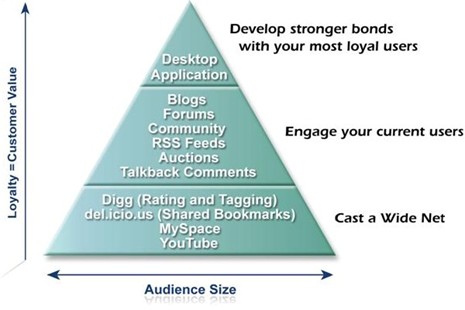Consumer-generated reviews. Blogging. MySpace. Viral marketing. There's no doubt about it, Web 2.0 is booming. And it's no wonder. These new technologies let people achieve the promise of the Internet—democratization of content creation and distribution. They put the power of the Web into the hands of individuals.
At the same time, this shift in power is wreaking havoc with marketing plans. As marketers, we are not used to relinquishing control. Giving up the driver's seat takes us out of our comfort zone. What marketers are now beginning to realize, however, is that this change also unearths a myriad opportunities.
We're all still learning how best to engage in the web 2.0 world and how it's impacting the customer/brand relationship. But one thing is certain: Brands have plenty to gain from adapting their marketing strategies to participate in these trends.
Navigating the Social Media Hierarchy
So, which Web 2.0 tools and technologies are right for you? If you're like most marketers, navigating and understanding the maze of technologies and sites can be daunting. Although slightly different from each other, their usefulness generally falls into one of three categories: new-customer acquisition, maintaining relationships with users, and rewarding and more fully engaging your most-loyal customers/advocates.
Using social media most effectively requires brand marketers to consider implementing some technologies in each of the categories.
Figure: The Social Media Hierarchy

New-user acquisition: Social bookmarking (like Digg and del.icio.us) and self-expression (like MySpace and YouTube) are valuable when trying to cast a wider net to attract more users to your brand. But brands need to tread carefully here. When participating in sites such as MySpace, marketers need to be up front about their intentions and their brands. Burger King has successfully created several profiles for its King character that have attracted mass attention, partially because those profiles added dimensions of creative expression that went beyond traditional advertising. Other advertisers, such as Adidas and Chili's, have created brand profiles on MySpace in what amount to large ads within which users can comment. Anytime a brand or group has been less than up front, such as the well-publicized "Wal-Marting Across America" blog campaign, user backlash has caused negative publicity that has far outweighed any positive publicity gained before the ruses were revealed.
Retaining and growing customer relationships: If the adage "your best prospects are your current customers" is true, then a plethora of new technologies can turn your brand-oriented, message-focused Web site into a vibrant community of engaged consumers. Management blogs, for instance, deliver a new dimension and insight into a brand's messages, as well as some of the corporate and product decisions it makes. "Talkback comments" invite outside perspectives through dialog with people who have a vested interest in the brand's success. Consider the community forums that both Cisco and Microsoft have added to their sites: These forums have helped ease technical support burdens by allowing customers who have experience solving a particular technical problem to contribute that expertise to other customers with a similar problem.
Most-loyal customers: The utopia for brands interested in using social media to maintain relationships with their most loyal customers is to capture a slice of their customers' desktops. Extending your brand to the desktops of your best customers provides a trusted environment for these customers to interact both with other loyal users, and with you—around your brand, with benefits that extend beyond those of traditional online communities.
A brandable desktop-based community provides benefits both to the brand that distributes it and the user who downloads it. Users enjoy tighter bonds with their preferred organizations through timely alerts, premium content, and valuable community interaction with other loyal customers. Brands enjoy an always-on connection to their most valuable customers and benefit from listening to the conversations of these users.
Building or Participating in Online Communities
Participating in existing communities: Though participations can be significantly labor-intensive, a brand can reap huge benefits by participating in communities outside of its own Web site. First, consider that two-thirds of all U.S. economic activity is influenced by shared opinions about a product, brand, or service, according to a Carlson Marketing survey. With the growth of social content, many of these shared opinions are moving online—giving brand marketers a previously nonexistent lens into the minds of their customers. By actively viewing and responding in forums where customers are discussing their products, brand marketers not only get a glimpse into what motivates their buyers and non-buyers they also correct or clarify any brand misimpressions. Second, 85% of consumers will recommend a company with which they have a trusted relationship, according to the same Carlson Marketing survey. Actively participating in online communities humanizes the brand to the audience and increases a feeling of trust between the consumer and the brand.
Creating or sponsoring brand-oriented communities: While for years sports teams have known the value to their business of building and maintaining a loyal fan base, other businesses are realizing that they, too, can gain huge benefits by building their own communities. For example, a Boston-based regional cable news station believes the direct-response nature of social media pays dividends both in brand trust and market research. Compared with the traditional way media companies determine their success (Nielsen ratings), community response via social media delivers more immediate and more relevant data to programmers. Not only does the cable station get data more quickly than by waiting for the Nielsen "book," it gains qualitative data that Nielsen numbers don't convey—namely, what resonates with the viewers. This is exactly the type of real-time insights the station gets by sponsoring and encouraging community feedback. The station has also found that because it participates in its own community, viewers appreciate that the station is being directly responsive. The feeling that there are real people behind the brand leads to increased feelings of trust and engagement by a consumer—which only benefits the brand.




